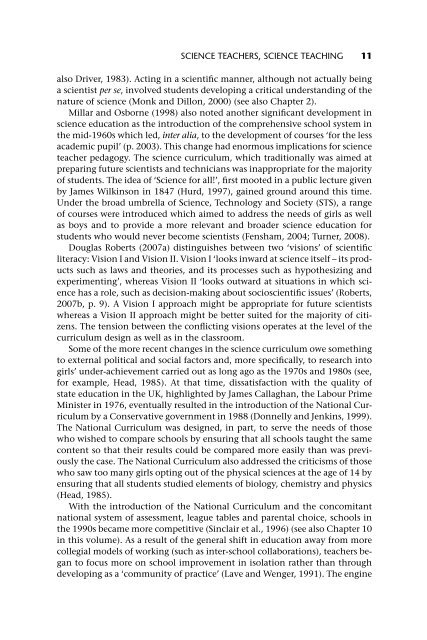good-practice-in-science-teaching-what-research-has-to-say
good-practice-in-science-teaching-what-research-has-to-say
good-practice-in-science-teaching-what-research-has-to-say
Create successful ePaper yourself
Turn your PDF publications into a flip-book with our unique Google optimized e-Paper software.
SCIENCE TEACHERS, SCIENCE TEACHING 11<br />
also Driver, 1983). Act<strong>in</strong>g <strong>in</strong> a scientific manner, although not actually be<strong>in</strong>g<br />
a scientist per se, <strong>in</strong>volved students develop<strong>in</strong>g a critical understand<strong>in</strong>g of the<br />
nature of <strong>science</strong> (Monk and Dillon, 2000) (see also Chapter 2).<br />
Millar and Osborne (1998) also noted another significant development <strong>in</strong><br />
<strong>science</strong> education as the <strong>in</strong>troduction of the comprehensive school system <strong>in</strong><br />
the mid-1960s which led, <strong>in</strong>ter alia, <strong>to</strong> the development of courses ‘for the less<br />
academic pupil’ (p. 2003). This change had enormous implications for <strong>science</strong><br />
teacher pedagogy. The <strong>science</strong> curriculum, which traditionally was aimed at<br />
prepar<strong>in</strong>g future scientists and technicians was <strong>in</strong>appropriate for the majority<br />
of students. The idea of ‘Science for all!’, first mooted <strong>in</strong> a public lecture given<br />
by James Wilk<strong>in</strong>son <strong>in</strong> 1847 (Hurd, 1997), ga<strong>in</strong>ed ground around this time.<br />
Under the broad umbrella of Science, Technology and Society (STS), a range<br />
of courses were <strong>in</strong>troduced which aimed <strong>to</strong> address the needs of girls as well<br />
as boys and <strong>to</strong> provide a more relevant and broader <strong>science</strong> education for<br />
students who would never become scientists (Fensham, 2004; Turner, 2008).<br />
Douglas Roberts (2007a) dist<strong>in</strong>guishes between two ‘visions’ of scientific<br />
literacy: Vision I and Vision II. Vision I ‘looks <strong>in</strong>ward at <strong>science</strong> itself – its products<br />
such as laws and theories, and its processes such as hypothesiz<strong>in</strong>g and<br />
experiment<strong>in</strong>g’, whereas Vision II ‘looks outward at situations <strong>in</strong> which <strong>science</strong><br />
<strong>has</strong> a role, such as decision-mak<strong>in</strong>g about socioscientific issues’ (Roberts,<br />
2007b, p. 9). A Vision I approach might be appropriate for future scientists<br />
whereas a Vision II approach might be better suited for the majority of citizens.<br />
The tension between the conflict<strong>in</strong>g visions operates at the level of the<br />
curriculum design as well as <strong>in</strong> the classroom.<br />
Some of the more recent changes <strong>in</strong> the <strong>science</strong> curriculum owe someth<strong>in</strong>g<br />
<strong>to</strong> external political and social fac<strong>to</strong>rs and, more specifically, <strong>to</strong> <strong>research</strong> <strong>in</strong><strong>to</strong><br />
girls’ under-achievement carried out as long ago as the 1970s and 1980s (see,<br />
for example, Head, 1985). At that time, dissatisfaction with the quality of<br />
state education <strong>in</strong> the UK, highlighted by James Callaghan, the Labour Prime<br />
M<strong>in</strong>ister <strong>in</strong> 1976, eventually resulted <strong>in</strong> the <strong>in</strong>troduction of the National Curriculum<br />
by a Conservative government <strong>in</strong> 1988 (Donnelly and Jenk<strong>in</strong>s, 1999).<br />
The National Curriculum was designed, <strong>in</strong> part, <strong>to</strong> serve the needs of those<br />
who wished <strong>to</strong> compare schools by ensur<strong>in</strong>g that all schools taught the same<br />
content so that their results could be compared more easily than was previously<br />
the case. The National Curriculum also addressed the criticisms of those<br />
who saw <strong>to</strong>o many girls opt<strong>in</strong>g out of the physical <strong>science</strong>s at the age of 14 by<br />
ensur<strong>in</strong>g that all students studied elements of biology, chemistry and physics<br />
(Head, 1985).<br />
With the <strong>in</strong>troduction of the National Curriculum and the concomitant<br />
national system of assessment, league tables and parental choice, schools <strong>in</strong><br />
the 1990s became more competitive (S<strong>in</strong>clair et al., 1996) (see also Chapter 10<br />
<strong>in</strong> this volume). As a result of the general shift <strong>in</strong> education away from more<br />
collegial models of work<strong>in</strong>g (such as <strong>in</strong>ter-school collaborations), teachers began<br />
<strong>to</strong> focus more on school improvement <strong>in</strong> isolation rather than through<br />
develop<strong>in</strong>g as a ‘community of <strong>practice</strong>’ (Lave and Wenger, 1991). The eng<strong>in</strong>e


